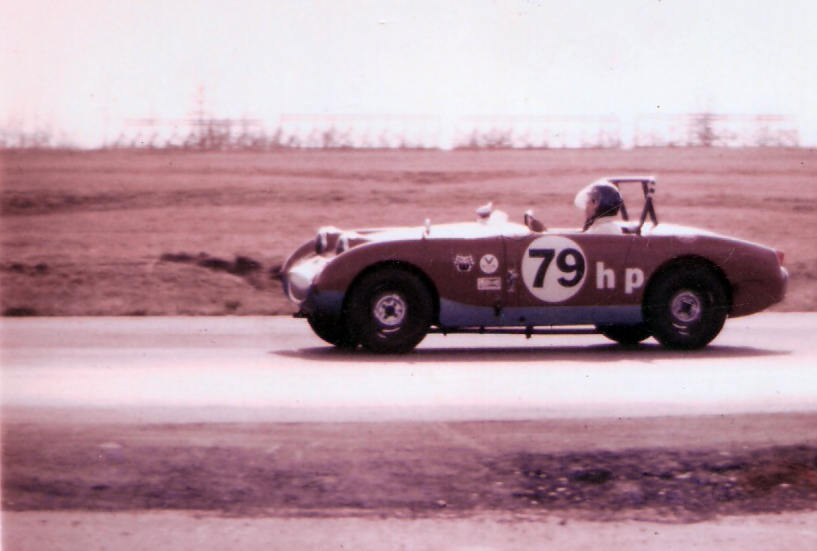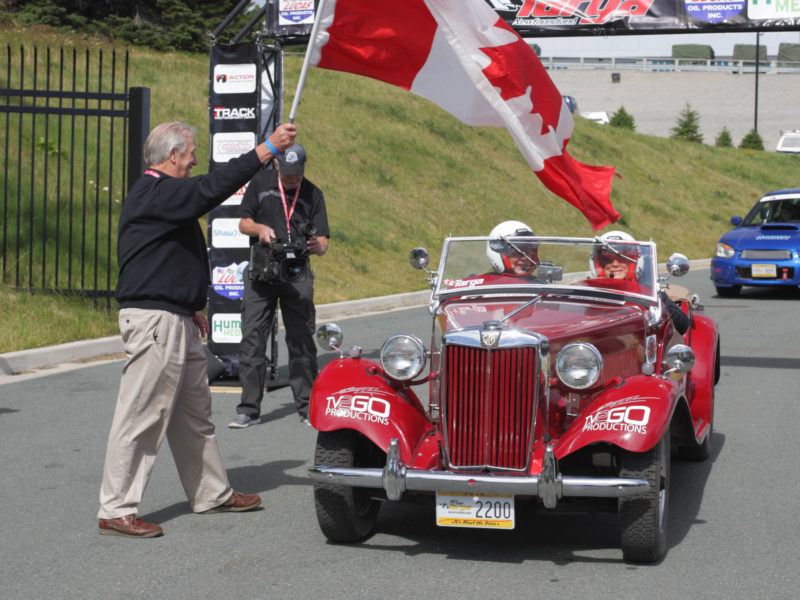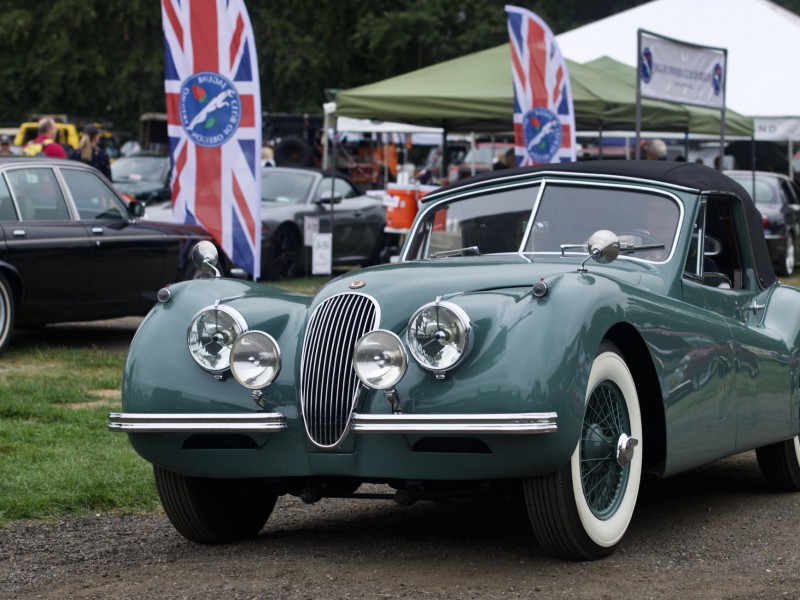The classified add read: “FOR SALE: ’61 Sprite, partially race-prepared, Engine rebuilt – $300. SW 4-1622 days till 7:00 pm.” We drove to Tom’s ABC Auto Service and there it was, a Cherry Red, H Production Bugeye Sprite with roll-bar, open exhaust, no windshield or front bumper. Too boot, it was a “Sebring Sprite” with 1 1/4-inch SU carbs, “hot” cam and tubular headers. It lacked disc brakes, close ratio gear box or limited slip differential, but it started right up and revved freely to 7,000 rpm. Cash money, no title, no questions asked.
To meet 1968 SCCA rules, it needed a flywheel scatter shield, racing windscreen, shoulder harness, and fire extinguisher. Within a week it was a race car. It also assumed its identity as “Number 79”.
My goals for 1968 were: earn my National License; graduate college and find a job; enter as many National races as possible, and qualify for the ARRC Runoffs at Riverside in November. A tall order, especially Riverside, but I had the car and the invincible spirit of youth.
The four races I needed to get my National License were the “Polar Prix” Regional at Green Valley Raceway in Texas in January, the “Frostbite Regionals” at Green Valley in February, and two Regionals at Warbonnet in Oklahoma in April and May. Our best finishes were a second and third in class at the Polar Prix, in spite of 20 degree temperatures. The only mechanical issue was the bending of all the push rods, also at the Polar Prix. Must have been the weather.
At the April race on Warbonnet’s short track, we beat eleven other H cars to finish an encouraging 4th in class. But the monumental event of the weekend was asking Ray Pickering for tips on Sprite race preparation. Ray, a grizzled veteran driver, had driven for the factory MG team at Sebring. Also, the number 83 Bugeye on the cover of Clymer’s Sprite-Midget Owner’s Handbook was prepared and driven by Ray himself. He told me, “Have you noticed it’s harder to push your Sprite with the steering wheel turned? Sprites have a design flaw and raising the steering rack 1/4-inch will correct it.” Ray disclosed what’s known as Ackerman. Since this modification was not legal in 1968, I made quarter-inch spacers out of ash, shaped them to the exact form of the steering rack mounts, and painted them aluminum. Longer bolts and new horizontal holes in the cross-member completed the trick. In the forty-four years since 1968 I have never seen another Sprite with this setup.
At our final Regional race on Warbonnet’s long track, I had a very spirited race with fellow Bugeye driver Tom Hall. His Sprite had disc brakes and more horsepower, but I had better handling. We changed places numerable times, taking turns falling off the track, or spinning into the weeds. On one lap, both of us spun out in the turn 5 hairpin, Tom to the outside, me to the inside: It was Corner Worker Pandelerium. Tom spun last at turn six and I beat him for third in class.
Graduating college in June, I was classified 4A by the Selective Service. The only “job” I could find was at Manpower Temporary for $1.50 per hour. This would earn me enough to race on a shoestring while I played the Draft Lottery.
A complete rebuild of Number 79 for National races was in order. The engine was balanced, the head milled .020-inches. Compression chambers and ports cleaned up according to Clymer’s. Many Hot Rod Magazine speed tips were used, like spacers instead of springs on the rocker arm shaft and grooving the oil holes on the rod bearings for better oiling. A competition oil pressure bypass spring was installed. The SUs were matched to the intake ports, and the butterfly shafts were cut and removed between ground-down attaching screws to improve airflow. Velocity stacks from J.C. Whitney finished the induction system. The twin pipe headers were merged into a single 2-inch pipe that ran the length of the car. A Lucas Sport Coil was the only ignition change. On the dyno we got a respectable 38 horses at the rear wheels.
For cooling the only modifications were a BMC thermostat blanking sleeve and a unique oil cooler. We flushed the heater core and ran Aeroquip hose from the oil filter through the core and back to the engine block. Leaving the blower motor in place, we had oil cooling on demand.
Number 79’s rear suspension was modified by re-arching the springs to make the radius arms parallel to the ground. The front springs were cut to even the front and rear ride heights. A 5/8-inch diameter front sway bar was added. The shock absorbers were flushed with mineral oil and refilled with STP. Negative camber of 3 degrees was achieved with spacers under the front shocks. Toe in was set at 1/8-inch.
Grey Rock cerametallic brake shoes, Sprite Mark III wheels and new Goodyear Bluestreaks completed the rebuild.
My First National Race was on my “home” course, the natural road course at Ponca City, Oklahoma. At the Saturday night race party, Race Starter David Wood gave me a tip, “Drop the clutch when the starter’s hand goes up. It will always go up slightly before it goes down.” Standing starts were required in 1968, and Number 79’s long ratio gearbox gave excellent starts. On Sunday Dave’s hand went up slightly, I dropped the clutch, and passed at least six cars going into turn one. By the end of the race I had fallen off the track only once, and I finished 4th out of 14 H Production starters. My first National points.
Three weeks later we took on the 2.5 mile track at Lake Garnett, Kansas. Circling the lake, this natural road course was proclaimed by Carroll Shelby as the “Best natural road course in America.” It had a mile long “Santa Fe Straight” running parallel to the rail road tracks. Number 79 actually ran out of revs before the end, even with 3.88 gearing. After finishing 7th out of 14 entries, I computed my top speed using the circumference of the Bluestreaks, the 3.88 gears and 7,000 rpm. We had gone 121 miles per hour. Pretty scary in a Bugeye.
 The Austin Aqua Festival Nationals were next; another road course, run on Riverside Drive and the parking lots of the baseball stadium and municipal auditorium. With temperatures in the upper nineties, I was the victim of home cooking. Qualifying fourth of four H cars, we were gridded way in the back of G & H Production, D Sedan and D Sports Racing. On the pole was the DSR Rattler from Corpus Christie, Texas. Powered by a converted outboard engine, the Rattler was very fast and got a lot of “pub” from the Race Announcer. But the Rattler wouldn’t fire for what seemed forever, the starter held the field, and number 79’s temp gauge “pegged” as the green flag fell. Midway through the race I stopped for water, but too much had been lost and we coasted to a stop too far from the finish line for a “heroic” push across the line. A finish would have been a National win since all of our competition had also succumbed to the delayed start.
The Austin Aqua Festival Nationals were next; another road course, run on Riverside Drive and the parking lots of the baseball stadium and municipal auditorium. With temperatures in the upper nineties, I was the victim of home cooking. Qualifying fourth of four H cars, we were gridded way in the back of G & H Production, D Sedan and D Sports Racing. On the pole was the DSR Rattler from Corpus Christie, Texas. Powered by a converted outboard engine, the Rattler was very fast and got a lot of “pub” from the Race Announcer. But the Rattler wouldn’t fire for what seemed forever, the starter held the field, and number 79’s temp gauge “pegged” as the green flag fell. Midway through the race I stopped for water, but too much had been lost and we coasted to a stop too far from the finish line for a “heroic” push across the line. A finish would have been a National win since all of our competition had also succumbed to the delayed start.
Back in OKC we discovered the head was cracked. A quick and excellent repair by a local oil patch welder, another .010” milling of the head, new rings and bearings and we were ready for Lake Afton, Kansas.
 Lake Afton was the third leg of the “Triple Crown” of true road courses in the Midwest Division. It had a long straight with hair pin turns at either end, connected with twisty bits. Our race there was not with other H cars, but with Bill Goodman’s D Sedan Saab. Evenly matched, I could corner better, but Bill had me on the straight. Lap after lap we were nose to tail, but I never lead at the start-finish line. On lap 16 number 79 simply shut off and we coasted off the track. In the rush to rebuild the engine after Austin, I failed to replace the ignition points. You guessed it, the fiber fin that rubbed on the distributor cam broke off, the points closed and the sparking stopped.
Lake Afton was the third leg of the “Triple Crown” of true road courses in the Midwest Division. It had a long straight with hair pin turns at either end, connected with twisty bits. Our race there was not with other H cars, but with Bill Goodman’s D Sedan Saab. Evenly matched, I could corner better, but Bill had me on the straight. Lap after lap we were nose to tail, but I never lead at the start-finish line. On lap 16 number 79 simply shut off and we coasted off the track. In the rush to rebuild the engine after Austin, I failed to replace the ignition points. You guessed it, the fiber fin that rubbed on the distributor cam broke off, the points closed and the sparking stopped.
On August 23, 1968, I was drafted into the Army and my Bugeye racing was over. I made Riverside as a spectator on a weekend pass from Fort Gordon, Georgia.
Number 79 was sold and its new owner drove it to his National License. When he ricocheted off two trees at Ponca City in 1969, the undamaged “tub” was sold and grafted onto the front of a Sprite that had been wrecked at Green Valley. That “hybrid” was raced extensively then sold in 1973. Since then the trail has gone cold but the memories remain.
By Steve England











'Number 79' have 3 comments
October 11, 2012 @ 12:53 pm Dean Parks
thanks for sharing your memories….
November 27, 2012 @ 4:34 am Jim Allen
Dean
I enjoyed reading the story of the “79” car. I can relate to much of the background as I did something very similar……but later in life and with a Mk II Sprite. It was the Genesis for Team 51 and the great little number 51 car. I have recorded much of that history on my web site should you be inclined to learn more. My car is now in the very capable hands of my daughter-in-law, so the story will have a new chapter. And soon I may have a grand daughter campaigning the car, which thrills me to no end.
Jim
January 30, 2014 @ 9:33 pm Eric Hunt
Born and lived in Ponca City until 1972. Loved to watch y’all race. Think I even remember the 79. Even though I was only 10.